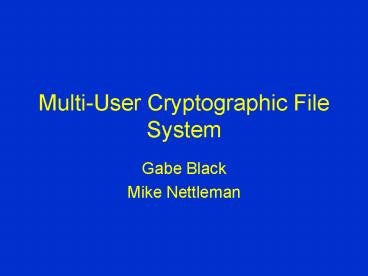MultiUser Cryptographic File System - PowerPoint PPT Presentation
Title:
MultiUser Cryptographic File System
Description:
Each file will have different keys. Block reordering. Implicit in hash ... Would require all files to have data encrypted with public keys, too time consuming ... – PowerPoint PPT presentation
Number of Views:38
Avg rating:3.0/5.0
Title: MultiUser Cryptographic File System
1
Multi-User Cryptographic File System
- Gabe Black
- Mike Nettleman
2
Overview of CFS
- Goals
- Interface
- Shortcomings
3
Overview of CFS Goals
- Transparent to Programs in the system
- Access time
- Access semantics
- Standard NFS once mounted
- Data encrypted
- File Names encrypted
- Do not trust the server
4
Overview of CFS Interface
- cmkdir
- Make an encrypted directory
- cattach
- Reveal the encrypted directory
- cdetach
- Remove the encrypted directory
5
Overview of CFS Shortcomings
- Keys are for the entire directory
- All files are encrypted with the same key
- Keys are for only a directory
- Must manually add all directories
- Sharing requires sharing the pass phrase
- To share a single file, a new directory must be
created - To give the pass phrase may be inconvenient
6
Multi-user CFS
- Users have globally accessible public keys
- System is mounted with Private Key
- Each visible file has multiple files
- Directory information
- If have permission, can decrypt names.
- Added commands to add or remove users from files
7
Files used in Multi-user CFS
- Key-file
- List of users and encrypted file keys
- File keys encrypted with the users public key
- Data-file
- What normally is stored in CFS
- Hash-file
- Integrity checking information
8
Major changes to CFS functions
- Keyof
- Read
- Files
- Directories
- Write
9
Keyof
- Takes cfs_fileid pointer as argument
- Original CFS
- defined access to internal data
- Multi-user CFS
- Uses fileid to find relevant key file
- Searches for user name in key file
- More likely to fail (user not in list)
- Would be better to find on open, but NFS has no
open command.
10
Read
- Read file
- Changed to use the integrity checking file
- Read directory
- Used in ls
- Changed so ignores hash and key files
11
Write / Create
- Write
- Changed so reads first
- Prevents verifying modified code
- Updates integrity file at the same time
- Create
- Creates all 3 types of files
- Chooses random file-key
- Sets attributes on hidden files appropriately
12
Added functions
- ReKey
- Verify entries in key-file
- Change the key used for the file
- Add user
- ReKey
- Add another username and key in the key-file
- Remove user
- Remove username from key-file
- Rekey
13
Comparison to Original CFS
- Transparent to Programs in the system
- Access time
- No key stream cached
- Multiple files
- Still reasonable performance
- Access semantics
- Remained the same
- Added files are hidden from user
14
Fixed Shortcomings of CFS
- Separated login-keys from file-keys
- Fixes problems of files sharing the same key
- Pattern analysis
- Partial substitution
- Allows fine granularity sharing without user
inconvenience - Sharing of keys does not require secure
communication - Uses Public keys.
15
Attacks Prevented
- Replace key-file
- Writes check integrity before writing
- Network sniffing
- Only encrypted data is transmitted
- Server is not trusted, so anything going to
server is could be viewed by anyone - Add self to list of users in key-file
- Rekey checks that entry is valid first.
16
Attacks Prevented
- Partial file substitution
- Each file will have different keys
- Block reordering
- Implicit in hash is block location
17
Vulnerabilities
- Authorized users
- Can modify files or add and delete users
maliciously - Denial of Service
- Files can be corrupted or deleted without access
rights. - No read / write separation
- Would require all files to have data encrypted
with public keys, too time consuming
18
Vulnerabilities, continued
- Complete replacement of files
- Create new file
- Semi-prevented by name encryption
- Copy file from somewhere else
- In process of adding path checking
- Attacks within client machine while directory is
mounted - All programs can access the files































